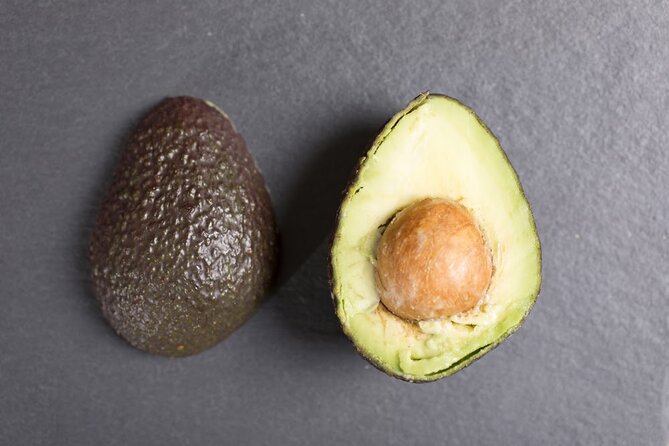A recent study published in the April 2021 issue of the Journal of Nutrition found that eating ONE avocado a day over 12 weeks could have a dramatic impact on metabolic markers and the microbiome (1).
Avocado is high in gut-supportive monounsaturated fats, fiber, and polyphenols – yet it also tastes great. Getting more calories from plant-based fat is a great way to promote whole-body health – while also crowding out the intake of grains, sugar, and high-carb foods.
The researchers found the following metabolic changes in the avocado-eating treatment group:
- Higher level of F. prausznitzii – a keystone strain of bacteria in healthy guts
- Lower insulin levels
- More production of short-chain fatty acids (SCFA’s) – substances used as fuel for healthy bacteria and intestinal cells – yet also created by healthy bacteria in the first place!
- Decrease in inflammation – inflammation starts as a healing response by the body – yet long-term inflammation means that the body has not been able to fully heal or continues to have too many insults to overcome – largely from diet and lifestyle. A body that remains inflamed will not be able to fully heal.
- Lower levels of primary and secondary bile salts – Bile acids not only help us digest fats but also act as signaling molecules. There is a delicate relationship between the ability of the microbiome to metabolize primary and bile salts.If primary and secondary bile salt levels become too high – they begin to have unwanted effects on digestion, detoxification, and the balance of bacteria in the microbiome (2 )
Similar strategies can be used to mirror the same results.
Many of these findings are consistent with what researchers associate with a healthy functioning gut and robust microbiome.
So while an avocado a day is one example of a small habit that can have far-reaching effects – there are a number of lifestyle habits that alone can provide powerful benefits – combined habits can make deeper changes.
For instance, here are some of the more powerful lifestyle strategies to improve the microbiome:
- Intermittent fasting – keeping all calorie consumption within defined 8-12 hour windows is a powerful metabolic and microbiome supporting strategy
- Consume diverse polyphenols, especially those from berries (>150mg per day). Cranberry polyphenols support Akkermansia muciniphila in addition to the support on microbial balance in the bladder and urinary tract. A. muciniphila is a keystone strain of bacteria in the gut that supports mucosal growth and healing.
- Polyphenols exert prebiotic effects on the gut in addition to their antioxidant, anti-inflammatory, and gene-modulating benefits.
- Targeted prebiotics like those in MegaPre by Microbiome Labs have been clinically shown to support A. muciniphila levels.
- Exercise and daily movement – these strategies lower stress, get you outdoors, boost metabolism, limit joint degeneration, and promote healthy gut motility.
- Getting outside and in nature through gardening, hiking, or more. Exposure to sun and natural life has powerful effects on serotonin, melatonin, and Vitamin D creation. Bacteria in dirt (Bacillus probiotics) and in grasses and the environment promote healthy immune responses. Serotonin is involved in gut motility and mood, melatonin supports sleep but is also a powerful anti-inflammatory hormone, and vitamin D also works as a powerful anti-inflammatory hormone that promotes gut integrity and immune balance.
- Live with pets and animals. Individuals who live with pets or on a farm routinely show healthier immune systems. Pets and other animals bring microbiome influences from the environment and help to stimulate and balance immune systems.Pets give us happiness, connection, and companionship in a world that, while counterintuitive, is becoming lonelier as we become more digitally connected and attached to our screens and devices.Pets benefit from a healthy microbiome too. While I’m not a veterinarian, I suggest a grain-free diet and Fidospore to my dog (and cat) owners!
- Maintain s healthy intake of omega 3 and anti-inflammatory fats. Omega 3 fats support a healthy microbiome in a number of ways. Balancing omega 3’s with other types of fats is also a key strategy for brain wellness.Reducing inflammatory vegetable oils (soybean, canola, corn, safflower, sunflower, and others) is also a powerful, if not the most important, strategy to reduce inflammation in the body.
- Take prebiotics, probiotics, and maintain diet diversity particularly in prebiotic fibers, polyphenols, flavonoids, and other rich phytonutrients.The more colors and diverse starches, greens, and fibers you can mix, the more you will promote flora diversity in the gut.The stronger the diversity of the gut, the more protected it is from invaders and opportunistic organisms, and the more your system can make compounds that keep it balanced and functioning optimally!
Introducing Postbiotics, the Metabolome, and the Microbiome
The diverse bacteria in the gut will naturally produce many bioactive compounds known as “postbiotics” – giving you an internal factory of numerous metabolites that help your body function at its best version of itself (3)
The sum total of all metabolites/postbiotics in your body is known as the “metabolome” – and you want it to be as rich as possible – it begins with diverse bacteria and that begins with a diverse and anti-inflammatory diet.
The field of “Postbiotics” and the “Metabolome” will be a rising trend in the world of not only creating and monitoring gut health – but also optimizing total physiology and wellness.
Microbiome science is revealing the ratios and diversity needed to optimize postbiotics and the metabolome – which is ultimately the goal of a healthy functioning gut – to extract and create materials from our food that the body needs to respond to its environment optimally with minimal collateral damage to our cells and tissues along the way.
Friendly bacteria in the gut produce more than 80% of all gut metabolites at this very moment! (4)
If the goal is to produce as many metabolites as you can, and the “metabolome” is 80% dependent on a healthy gut microbiome – optimizing the gut microbiome and its exposure to diverse nutrients and food is the primary way we have to improve the metabolome and the ability of the body to function this very moment.
As we’ve learned, boosting microbiome diversity comes back to eating a diverse diet in fruits, vegetables, fibers, and starches – and avoids general overeating, a high intake of inflammatory oils, as well as the consumption of inflammatory grains.
You now have your roadmap for supporting a healthy microbiome. You can get very specific with that roadmap by measuring the diversity and function of the microbiome.
We use BiomeFx by Microbiome Labs for personalized microbiome analysis.
Aside from direct feedback from microbiome testing, here are some specific tactics to help you along the way…
Top Supplement Strategies to Support a Healthy Gut Microbiome
- My favorite sources of probiotics, prebiotics, and polyphenols include Megasporebiotic, MegaPre, MegaMucosa, and Sunfiber. I like additional probiotic formulas such TrubifidoPRO, TheralacPRO, or Ther-biotic Complete as potent supports to take alongside Megasporebiotic.Taking probiotics and prebiotics together produces a synbiotic or synergistic benefit. Some formulas combine them for you such as Ther-Biotic Synbiotic.
I will mix and match formulas every month or so to find a personalized mix or to rotate both prebiotic and probiotic formulas to support wider diversity.For more specific details, check out my Probiotic Blueprint.Megasporebiotic contains spore probiotics that have different characteristics from other probiotics. Most notably, they’ve been clinically studied to reduce leaky gut in as little as 30 days.
These specific Bacillus strains support my 7 core strategies to healing leaky gut naturally and the growth of other beneficial bacteria. Megaspore continues to be the favorite product of my readers and is one product I’m sure to take daily.
Check out our Megasporebiotic reference page for a deep dive into all of the research behind these beneficial organisms.
- MegaMune by Microbiome labs is formulated with nutrients and plant compounds that support everyday immune health – that also work to support general microbiome health. It’s a great tandem immune support and balance formula with spore probiotics as it contains well-researched nutrients and polyphenols.
- Consider dietary and supplemental sources of green tea extract (EGCg) such as in Teavigo, beta-glucans such as those in mushrooms and ImmunoMax, and the antioxidant, gene-modulating, and gut-remodeling benefits of resveratrol found in grape skins and red wine.
- Curcumin, as Theracurmin HP, remains one of my favorite ways to support inflammation, detoxification, brain, nerve, immune, and gut health.
Theracurmin, at the time of this writing, is the most absorbable form of curcumin by many degrees.Because it is also water-soluble, it is much less likely to irritate the gut like other forms of curcumin.
“De-flaming” the gut is one of the first of the seven core strategies to heal the gut. Microbes call the gut lining home – and the gut lining cannot be inflamed and healing at the same time!
There are dozens, if not hundreds of plant chemicals that I work with that may have profound results for the health of the microbiome, nervous system, blood sugar, metabolism, and more.
A daily green smoothie, that includes some avocado and added prebiotic and polyphenols can be an easy way to integrate a number of gut-supporting nutrients in one easy swoop. I’ve highlighted a shortlist of some of my favorite strategies above.
As the avocado study demonstrates, one change done with consistency can have a dramatic effect on metabolism and the gut microbiome.
When it comes to supplements, Nature has luckily provided us a bountiful dispensary to choose from!
All that is left is consistency and variety as the final keys to a gut healing strategy.




